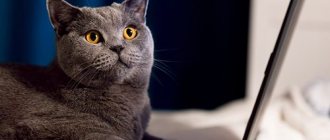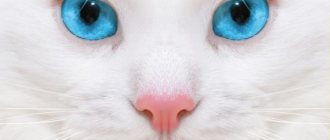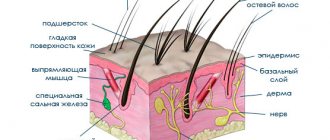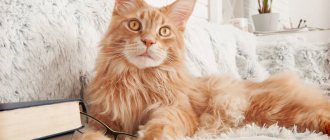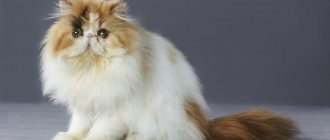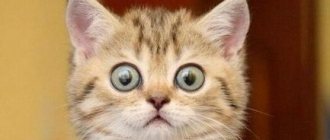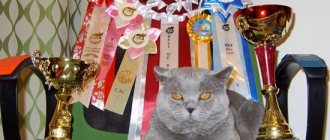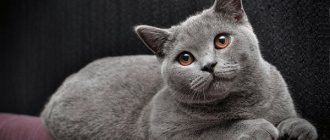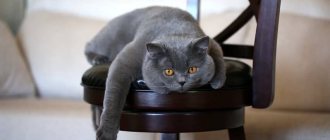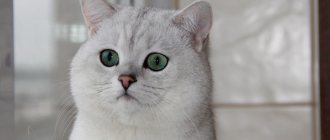British Shorthair: Pixabay The British cat is the embodiment of aristocracy, primness, independence and leisurely behavior that are inherent in members of the British royal family. At the same time, this soft plush cat is a good friend and companion for humans. He is unobtrusive but friendly. Find out the details of the character and behavior of the British cat, as well as the peculiarities of caring for animals of this breed.
Contents of a Black Briton
British cats are a fairly easy-to-care breed; if properly maintained, British cats can easily live up to 15-16 years of age without causing much trouble to the owner. Therefore, the key points that the cat owner should know are mainly related to the animal’s nutrition.
Feeding a British cat
The owner of the animal can choose two feeding options - natural food or a diet consisting of high-quality dry food. It is impossible to mix two types of diets, as this is fraught with gastrointestinal problems for your pet. If we talk about industrial ready-made food, then you need to choose the “super-premium” or “holistic” lines, if possible selecting the specific breed of food. Many brands offer food made and selected specifically for the British breed.
Royal Canin for British cats
However, modern food is not necessarily selected strictly for the breed - it is better to focus on the characteristics of the animal (homebody, castrated or sterilized animal, walking on the street, and so on). Each pack contains a table from which you can easily find out the daily dosage of food for a Briton - just weigh the animal and follow the manufacturer’s recommendations.
British cats are prone to obesity, so you should not overfeed your pet or leave food freely available.
An adult should be fed twice a day, morning and evening; the rest of the time there should be only clean, cool drinking water in the bowl - this is important!
To prevent your cat from suffering from excess weight, the serving size needs to be adjusted.
The natural nutrition of a British cat is based on fresh raw meat (turkey, veal, rabbit are preferred). There is no need to boil the meat, in which case it loses its beneficial properties, just pour boiling water over the piece before cutting and immediately offer it to the cat.
Food from the master's table is not suitable for the British; there is no need to cook porridge or soups for the cat - they negatively affect the digestive system of the predator. To raw meat you can add grated raw vegetables (pumpkin, carrots, zucchini), quail or chicken eggs, and finely chopped herbs. Every day a cat eating natural food should receive kefir or cottage cheese. You need to remember that in terms of the amount of protein, curd mass is equivalent to meat, and balance the diet based on this - an excess of protein “hits” the liver.
Fresh meat should occupy at least 60% of a small predator's bowl
In addition to meat, dairy products, vegetables and herbs, British cats should receive additional mineral and vitamin supplements - high-quality complex vitamins can be purchased at a pet pharmacy (Canina, 8 in 1, Beafar, Polidex).
British black cats benefit from adding a little kelp seaweed to their daily dose, which maintains and maintains the bright charcoal color of their coat. Dietary supplements for cats containing kelp are also sold in pet stores.
Treats with kelp for cats
Black British coat care
The short but thick coat of a British cat requires some attention from the owner - once a week the cat needs to be thoroughly combed with a slicker brush with droplets on the tips of the teeth or with a special massager. During the molting period, grooming procedures should be carried out more often - once every two days, carefully combing out the dead undercoat. A kitten must be taught to brush itself from a very early age, otherwise a wayward adult cat may resist.
British cats are washed once every six months, or when soiled, if the animal has access to the street or spends the summer season outdoors. For washing, special shampoo for animals should be used. For black Britons, we recommend lines of cosmetics designed specifically for dark coats: “Royal Groom Black Pearl”, “Ring 5 – Black Out”, “Kiss Black Bagheera” and the like.
The British are clean and do not need to be bathed often
General Content Rules
Like any cat, the British cat must regularly undergo the following procedures: annual vaccination and quarterly deworming treatment. If your pet has access to the street, during the spring-autumn season you need to treat it against ticks and also wear a flea collar. Also, cats walking outside should have a separate thin collar on which will hang a tag with the owner’s phone number.
Cats must be vaccinated
Buy a British kitten: mission possible
People often mistakenly believe that due to the enormous popularity of this breed, buying a British kitten is an almost impossible mission for an amateur, since kittens are sorted out at the speed of sound even before birth. Fortunately, this is not the case. Kittens are not difficult to find, the main thing is not to become a victim of deception or fraud.
And, if you are an ordinary amateur, and not a professional breeder, then the best way to avoid deception is to contact a trusted nursery or take the advice of a specialist you know.
We have put together a collection of links to sites where you can choose a kitten for yourself.
Buy a kitten in Moscow
On average, a purebred kitten of the British breed with all documents in the capital of Russia costs from 10,000 to 50,000 rubles.
We offer you the Top 5 proven and worthy sites that provide the opportunity to buy British kittens in Moscow:
Photo source
- SunRay is interesting because it periodically gives into good hands (for a purely symbolic fee) purebred kittens from parents who are retiring.
- JoyLand is a British cattery operating since 2000.
- Style of Provence - has been breeding pets since 2012, recently joined forces with the ILIOS CATS nursery.
- Tamaky RU - cats are given away after complete deworming, adapted and accustomed to the toilet and scratching post.
- Avito is for those who want to save money. Here you can buy cats cheaper, from 3-5 thousand rubles, but you don’t always come across responsible and honest breeders. You can end up with cats without documents, guarantees, or even sick animals.
Our dear readers, please share in the comments to this article information about proven nurseries that breed British Shorthair cats in Moscow and other cities of Russia, or reviews about those organizations that we have given in the list above. Thank you in advance!
Buy a kitten in Kyiv
For those wishing to buy a kitten of the British breed in Kyiv, there were three nurseries:
Photo source shutterstock.com
- Devinore UA - has been operating since 2006, the main color of the cats is tabby.
- Vijuha are kittens with bright orange eyes.
- Joy my Soul - in addition to the classic British breed, you can buy rare Selkirk Rex kittens here.
As an option for residents of Ukraine who do not want to overpay money in nurseries, there is the OLX website, an analogue of Avito, but you should be very careful when purchasing on such sites, as you can end up with people who breed British kittens at home, as well as scammers, those who want to deceive you and lure you out of money. Yes, on this kind of resource prices for the British are much lower and start from 250 hryvnia, while in nurseries - from 1,000 to 15,000 hryvnia, but the risk of becoming a victim of deception is much higher.
If you live in Kyiv and know decent catteries of British breed cats, share information and contact details in the comments under the article!
Buy a kitten in Minsk
If you live in Minsk and are looking for a British cat, you can look into the following British kitten nurseries:
Photo source
- Elite British - at the age of 2 months, the kittens of this nursery undergo certification (examination by specialists for breed), without this documents are not issued.
- BriCat.by is a professional certified nursery with expensive kittens.
- Avicats.com - has been operating since 2008, the pride of the nursery is producers with golden colors.
If you have a limited budget, you can take advantage of the offers of the Doska.by service and buy yourself a pet for an average price of 10 Belarusian rubles. However, in this case, you probably shouldn’t rely heavily on purebred, since kittens of elite “blue” blood are most often available in the capital of Belarus at a price of 100 Belarusian rubles and more.
If you know where verified nurseries of British kittens are located in Minsk and other cities of the Republic of Belarus, please leave information in the comments below!
Contents of a Black Briton
Contrary to popular belief that the British are difficult to look after, the reality is completely different. If you follow simple rules of care, a four-legged animal can easily live up to 18, and sometimes 20 years.
There are just a few nuances that you should pay attention to.
Namely:
- Avoid hypothermia of animals and do not place their houses in drafts. Representatives of these breeds have weak eyes. Therefore, at the slightest breath of wind, their eyes begin to water and sour.
- Visit a veterinarian regularly, especially for owners of animals over 10 years old, and get vaccinated.
- Feed your cats correctly.
- Do not allow frequent matings (for cats), this weakens the immunity of fluffies, they begin to get sick often.
Caring for cats involves proper feeding. This can be high-quality dry food or canned food, as well as natural food.
First you need to decide, and then carefully select your diet. If preference is given to dry food, then it is better to choose the holistic or super-premium lines. Many brands offer food specifically for the British, taking into account their age.
At the same time, veterinarians advise choosing food based on the four-legged lifestyle. If the animal is overweight, then it is worth purchasing appropriate food. If the cat does not leave the house, therefore, it is necessary to purchase appropriate food. It's all written on the packs. In addition, veterinarians working in specialized pet stores will always give advice and help, so this will not be a problem.
Some owners worry that their British black kitten will go hungry while they are at work. Therefore, they leave the drying directly in the bowl, pouring it with a mountain. This cannot be done because, firstly, the feline’s stomach will quickly stretch out, and secondly, they will get used to the fact that they can eat as much as they want, and then they will not leave their feeder. Considering that the British are prone to obesity, doing this is strictly prohibited.
Animals must be given eggs at least a couple of times a week. The same applies to dairy products. True, there should not be an excess of them. To maintain the charcoal shade of the coat, you can add kelp to your food from time to time. If the cat is repelled by the smell, then it is worth buying vitamin complexes that contain these algae and giving them.
You should forget about food from the table. British black cats, like representatives of other colors, begin to get sick if they consume fat, salt and spices in excess. All this is present in the food that a person eats. All this is prohibited for animals.
Grooming
Many people believe that the British Shorthair black cat's coat does not need to be looked after. However, it is not. If the animal is not combed at least once a week, the hairs will begin to tangle and cough. Therefore, this procedure cannot be avoided. To do this, it is better to buy a soft brush that will not injure the skin.
Cats should not be bathed frequently. If the animal walks along the street, then “bath days” must be organized 2 times a year. For bathing, you should take shampoos designed specifically for black Britons. These cosmetics are sold in pet stores.
Health
British cats are one of the healthiest cats, as they do not have any serious health problems. This breed has a good gene pool, so the British have been used to develop new breeds for many years. The only contraindication is drafts, since sitting in a draft can easily catch a cold. It is better to protect a pet of this breed from fatty foods, as there is a tendency to become overweight. To achieve an ideal balance in nutrition, you should switch the animal to ready-made canned and dry food. During the growth period, kittens, pregnant and lactating cats need to add natural food to industrial food.
The British breed is never crossed with the Scottish Fold, as the result is sick kittens with paralysis and dysplasia. In the 70s of the last century, a kitten with hemophilia was born, breeders certainly began work to identify carriers. As a result of the work, scientists found that the majority of British people are born with blood type A, and a minority have blood type B. Mating of animals with different blood groups leads to a conflict of Rh factors, that is, incompatibility. The British breed is characterized by late maturation. By the age of three to five, British kittens are fully mature, but thanks to this delay in development, they look young in adulthood. Representatives of this breed are long-lived, usually living up to 20 years.
Origin of color
The first British cat of Blue color appeared in 1871 and took first place at a cat show. The cat was introduced by breeder Harrison Ware. The appearance of the Briton charmed fans, but only in 1950 did she gain recognition in American felinology.
For over a hundred years, breeders have worked to achieve the perfect standard of the British Blue. To achieve the result, they were mated with various breeds of cats: Persian, French, and blue Russian cat. It has been established that the recessive Blue tone is a diluted black pigment. Therefore, the color varies over a wide spectrum from dark graphite to light gray, rich blue. Now certain standards have been established for the color of the breed; according to color, it is rated up to 25 points.
Breeders have difficulties with breeding; according to the rules of genetics, this is a recessive color and two Blue parents can produce the same kittens of both sexes. When mating with other colors, it is difficult to get blue kittens.
Eyes
Not only the beautiful, soft, shiny coat evokes admiration, but also the charming, large, round eyes. They are widely spaced relative to the nose, which gives them more expressiveness. The coat color of a British cat looks good in the photo in combination with their eyes, which are copper, orange, and golden.
Due to the yellow color of the eyes and the gray-blue color of the coat, the pure British cat is sometimes confused with a mixed breed from a Russian cat, but they are distinguished by the shape of the head and the full cheeks characteristic of the blue solid.
British breed cat hair
Short, thick, shiny, dense, with a thick undercoat. Exotic shorthair cats are “hiding” in the ancestors of the British, known carriers of the hidden gene for long hair. Therefore, sometimes a long-haired miracle suddenly appears from two short-haired parents. The WCF system is now working to separate the two, and soon matings of shorthairs with longhairs will be prohibited.
Alas, of course, not everyone can boast of a short plush, real, thick, so that it would be impossible to reach the skin. Often the coat is still a bit long, especially in the back area near the tail and on the belly.
Eye color in black Britons
Among the variety of cats of the British breed, the following are distinguished:
- blue and purple shades;
- golden color, currently considered the most original and expressive;
- silver British cats, especially those with blue eyes;
- British chinchillas of all types of colors.
All Britons have blue eyes, but only up to four months. After this, the shade changes to gold. Some kittens may have green eyes, but breeders note that in this case the likelihood that the baby will turn black at the age of 6-7 months is zero.
"Big" in languages of the world
The easiest way to indicate your cat’s heroic status is to give him a “giant” nickname. Words in different languages of the world that mean “big”, “giant”:
- Big (English)
- Large (English)
- Grit (English)
- Gros (French)
- Grand (French)
- Grandy (Portuguese)
- Megalo (Greek)
- Kun (Korean)
- Goz (German)
- Grotto (Dutch)
- Oki (Japanese)
We recommend watching: 348+ beautiful names for chameleons
Persian cat Procrastinator
Features of British hair care
There are also some differences regarding the hygiene and living conditions of black British cats.
- British fur coat color can vary depending on diet. For example, food containing beets is suitable for dark-colored cats. But a large amount of seafood on a cat’s menu can negatively affect the color of the paws and nose - these areas of the body will become lighter, in contrast to the main shade.
- When exposed to ultraviolet light, a black cat's fur becomes dull and takes on a gray tint. To restore color, you will have to limit the time your pet stays in direct sunlight.
Despite the short hair, the British cat needs regular brushing during shedding. The procedure is carried out several times a day using a special mitten or comb.
The chin of a British breed cat
Strong, smooth. The line from the nose to the chin is vertical. In addition to the traditional drawback for all breeds - underbiting, the British have another problem - excessively narrowed, so-called “fox” muzzles or simply a narrow chin. Listen, comrades! The Briton is the Arnold Schwarzenegger of the cat world! How can you imagine Arnie Schwartz without his famous “cast iron” jaw?
How do kittens' eyes change?
The final eye color in cats is established by the age of 2 years. The process of changing the color of the iris is called reblooming. Most often it begins in the 4th week of a kitten’s life. In this case, the usual blue tint of the eyes is diluted with splashes of a different color. Gradually, these inclusions grow and the animal’s eyes acquire a constant shade.
So, if you have a preference for cats with a certain eye color, adopt a kitten at 4 months of age. At this time, it is already possible to determine what color of the pet’s iris will be. Later it may acquire greater depth and richness, but its basic tonality will remain unchanged. It is worth noting that eye color is not a feature of a particular breed. This is a purely genetic criterion, where blue color is a recessive trait.
If you have decided to become the proud owner of a British kitten, you probably have many questions about choosing and keeping your little friend. And the first thing you need to do is decide who you want to be your little friend - a cat or a female cat. Often people do not think about this issue while the kitten is small, but when the baby grows up, the situation changes, because a lot depends on the gender of the animal.
Experts say that cats are less demanding and more friendly by nature than cats; as for the British female sex, cats are very serious, jealous of their owners and strongly attached to them. But again, any animal is a personality, and cat riddles are not so easy to solve by looking at a cute little and fluffy kitten with a charming, naively playful look. And in any case, like any other cats, the British require a lot of attention, affection and love, while they are always sociable, trusting and really miss their owners.
When buying a kitten, many people immediately pay attention to the eye color of British kittens, it is amazingly beautiful - blue-gray! But here it should immediately be noted that with age, the color of the kitten’s eyes will change in any case, but more on this a little later, since first you need to choose the right age of the animal when purchasing. When choosing a pet, you should definitely take into account that the older he is, the better for you and for him.
Kittens up to a month old should not be separated from their mother at all, because they are still too small, need mother's milk and can even die from insufficiently developed immunity or stress
When choosing a pet, you should definitely take into account that the older he is, the better for you and for him. Kittens up to a month old should not be separated from their mother at all, because they are still too small, need mother's milk and can even die from insufficiently developed immunity or stress.
Moreover, if you like a certain eye color in British kittens
, then it is very difficult to determine this at a young age. Only after several months can we say what it will be like, since by then the first moult will have passed and the color will begin to change.
The final results will be clearly defined only by the year, but, nevertheless, already at four months the eye color of British kittens can be judged by the general tone. At this age, a specialist will already be able to tell you whether they will be yellow or dark orange.
You also need to pay close attention to ensure that the kitten’s eyes are clear and do not have a visible third eyelid or discharge.
How to determine the eye color of British kittens in advance? It is known for sure that British cats of classic color can only have copper-colored eyes (from amber-golden to rich dark copper); in this case, neither blue nor green eyes are allowed in adults. In other British breeds, eye color directly depends on coat color. The most diverse range is observed in British white cats; these beauties can have eyes of blue, gold, or all shades of copper colors. Another feature of white cats is the ability to have eyes of different colors, most often gold and copper shades.
By the way, there are many who want to buy just such an unusual and cute kitten with completely different eye colors.
In white, silver, golden British chinchillas, the eye color can be emerald green, and in color point cats, the eyes can also be blue.
Character
The British breed is known for its balanced, aristocratic, intelligent character. They are quite independent and get along with people and other animals. Little curious. When guests come to the house, they try to hide in a secluded place in order to avoid unnecessary attention to their person.
They are not inclined to show aggression and are patient. They are trusting and attached to their owner, prefer to be close to him at a distance, but do not particularly like to be held. The British breed represents the ideal unobtrusive companion with a phlegmatic and calm temperament. This is a cat that is “on its own”, not fussy, measured, and a little talkative. Adult animals moderately love to play, are more lazy and prefer to sleep than run around the apartment. The British are smart, stubborn and calm, but touchy. Having offended your pet, you will have to win his favor with affection and attention.
Description of the breed
The physiology and appearance of the British were formed under high humidity in cold climates, therefore this breed has dense short hair that protects from cold and moisture.
Since British cats are excellent hunters, they are strong, hardy and unpretentious in food.
The breed standard describes the British as follows:
- The head has a wide skull and is round. The cheeks are developed, the cheekbones are wide, the muzzle is flattened and round.
- The nose is wide, straight and short.
- The ears are rounded and small, set wide and low.
- The eyes are round, at a great distance from each other, which exceeds the width of the nose.
- The body is massive, with a developed chest and good muscles.
- The limbs are powerful, but short. Paws are rounded.
- The tail is thick.
- Weight - Males weigh 10-13 kg, and females from 6 to 9 kg.
Wool protects cats well from the cold due to the developed undercoat. It does not adhere to the body, is thick and plush to the touch.
Sometimes there are longhaired British cats. A recessive gene is responsible for long fur, so a long-haired kitten cannot appear from ordinary parents.
People often confuse British and Scottish cats: some even seriously think that there is such a breed - the British Fold. The two different breeds should not be confused.
Popular names
Not all cats that come across as fat, lazy gluttons actually are. Some purrs really have “wide bones” and “fluffy fur,” so visually they seem thicker than they really are. These giant cats include Maine Coons, Ragdolls, Ragamuffins, Siberian and Norwegian forest cats, as well as British and American bobtails.
The most common nicknames for male cats of these breeds are:
- Aberdeen
- August
- Azur
- Aldo
- Amaris
- Aslan
- Asterix
- Attila
- Achilles
- Bacardi
- Bayda
- Baloo
- Boniface
- Bruno
- Bourbon
- Valentine
- Jack
- Walter
- Varden
- Watson
- Washington
- Viking
- Viscount
- Windsor
- Hannibal
- Hamlet
- Gandalf
- Hercules
- Guinness
- Horace
- Gustav
- Grant
- Damian
- Dionysus
- Dan
- Joker
- Georges
- Rajah
- Zorro
- Yoda
- Casanova
- Cactus
- Cornelius
- Space
- Kramer
- Lucas
- Magnus
- Morpheus
- Nils
- Ninja
- Obelix
- Poirot
- Pierrot
- Rajah
- Simon
- Sapphire
- Sultan
- Tabasco
- Thorin
- White
- Hurricane
- Faust
- Fruit
- Hank
- Tsar
- Caesar
- Shaman
- Sherkhan
- Edward
- Eugene
- Yakov
- Jaromir
Blue-eyed giantess Bianca of the Ragdoll breed.
The most popular nicknames for large girls:
- Aurora
- Azara
- Alice
- Iris
- Azalea
- Bastet
- Beatrice
- Bestia
- Bagheera
- Bianca
- Squirrel
- Vasilisa
- Vesta
- Vanessa
- Violet
- Byzantium
- Grace
- Galatea
- Grace
- Glasha
- Glucose
- Jesse
- Doria
- Dunyasha
- Blackberry
- Jasmine
- Josephine
- Zlata
- Toffee
- Inessa
- Ishtar
- Cleopatra
- Cassandra
- Weasel
- Lilith
- Letitia
- Louise
- Marusya
- Melissa
- Marquise
- Mint
- Nessie
- Nymph
- Nesmeyana
- Nefertiti
- Nancy
- Nyusha
- Olivia
- Pixie
- Penelope
- Lynx
- Rhyme
- Radish
- Sabrina
- Sybil
- Trixie
- Trinity
- Tusya
- Ursula
- Umka
- Felice
- Hilda
- Halva
- Scratchy
- Queen
- Chuchundra
- Charlita
- Chara
- Shurshilla
- Shushu
- Skoda
- Charlize
- Charlotte
- Juno
- Yasmina
- Jasper
- Java
Maine Coon Grand
Content Rules
Proper care of an adult pet or kitten will preserve and prolong the health of the animal. British cats need regular coat care: combing, bathing, grooming. The fur of cats of this breed is thick and short, and the animals themselves are very clean and groom themselves thoroughly. But they need to be combed to get rid of lost hair and to add shine and shine to the coat. The cat licks the fallen hair and swallows it.
Hairs collect in the stomach in clumps and cause discomfort, this can lead to serious illnesses. Therefore, pets should be combed regularly and given special medications to prevent the accumulation of hair in the body.
It is also necessary to clean the ears and nose and trim the nails once every few weeks. You can help wash your cat's eyes daily. The teeth of the British also need to be monitored and periodically given special dry food for tartar. In addition, purebred individuals are susceptible to many genetic diseases.
Care
British cats should be taught to use a comb from childhood, as the fur on the belly is quite difficult to comb. They have a fairly good, thick undercoat, so for this procedure it is better to use a slicker brush with metal teeth rounded at the ends. Brushing twice a week is enough for the animal to get used to the “beauty session” and enjoy it. During shedding, you need to brush more often. The British breed is the only breed that enjoys brushing and stroking against the coat.
Britons give birth to very large cubs and, as they grow up, they become very active with a large source of energy. The cat takes very touching care of the kittens and almost never lets them go. The cubs open their eyes after about a week. Kittens grow very quickly and become large and dense, but they do not get fat. The cat grows until about four years of age and reaches full bloom at five years of age.
When choosing a British kitten, be vigilant. The ideal age for a kitten to be rehomed is between 12 and 16 weeks. British cats usually have small litters, as the kittens are born strong and large. By three months, they not only have good physical development, but also acquire social skills.
On average, British Shorthair cats live 18-20 years. A British cat can be considered an ideal acquisition for a number of reasons. They exude kindness, they have a pleasant character, a presentable appearance and a calm temperament. All this ensured this breed great popularity. Due to their character and low maintenance requirements, cats are ideal for owners who spend all their free time working.
It is worth keeping in mind that this description is typical for the breed as a whole and may not completely coincide with the characteristics of a particular cat of this breed!
British breed standard
To figure it out for sure, you need to delve into the approved British standard and at least approximately understand what a worthy representative of the breed should look like.
When choosing a black kitten, the future owner must be sure that he is purchasing a British cat, and not a cat with a similar phenotype.
Table 1. External features of British cats
| Parameter | Description |
| Head | As the British say: “The whole breed is in the head.” Indeed, British cats are distinguished by a characteristic large head, round in shape, with wide cheekbones and pronounced “chubby” cheeks. The forehead is round and flat, the nose is short and straight. |
| Chin | Strong, massive, straight (perpendicular to the mirror of the nose). The British jaw should not be narrowed or thin. |
| Ears | Small, low set, rounded at the tip. A Briton's ears should be at an angle of ninety degrees to each other, if the apex of the angle falls on the bridge of the animal's nose. |
| Frame | Short, squat, muscular. Both male and female cats are distinguished by their massiveness, but not looseness. The animals are distinguished by a wide chest and powerful hips. |
| Limbs | Medium length, thick and strong. |
| Tail | Wide at the base and rounded at the tip. Medium length, quite thick. |
| Eyes | Large, wide-set and open. The iris of British cats reaches its final shade quite late, perhaps by the animal’s year. |
| Wool | Thick, dense and shiny, with good undercoat. Ideally, a Briton's fur coat should resemble stuffed plush, so that the animal's skin is not easy to touch. |
What should/shouldn't the head of a thoroughbred Briton look like?
Characteristics of British behavior
The British Shorthair cat must be raised for up to one year. At this time, you can instill in him some character traits. After a year of life, it will be too late to change anything. And if a cat behaves badly, this is a consequence of poor upbringing in childhood.
This noble breed means that its representatives devote a lot of time to their appearance. Licking is a favorite pastime of these cats.
Despite the fact that the British breed is quite positive regarding its behavior and character, there are still features that cause a lot of discontent among British owners:
- Scattering things and objects. Even in childhood, kittens need to be weaned off this “cute” behavior. Indeed, at first it looks charming both in the photo and in reality. However, in the future, flower pots, vases, etc. will be used. To do this, you need to treat your “favorite” things with special compounds.
- Playing with the hands and feet of its owner. It is better to offer your baby a scratching post or special toys.
- The British are incredibly curious. Therefore, they can easily be found in packages, new things, and hard-to-reach places. You can often come across photos like this that only cause tenderness.
The British breed is one of the most popular in the world today.
Such cats attract attention not only with their cute appearance, but also with their unpretentious character.
Why do kittens' eyes change color?
Eye color in cats depends on the amount of coloring pigment. Therefore, the reason for the change in eye color is the accumulation of melanin in the eyeball during the development of the visual organs. However, blue color is a recessive trait, which is why eyes of this shade are very rare.
Otherwise, they are sweethearts and are not allowed at home. The British cat's coat requires minimal care, simply brushing it once a week. It is good to remove dead hair more often during the licking period. The chests do not need to be reduced if they do not protrude even when pulled. Overgrown nails can be avoided by purchasing scrapers.
Standards and features. The British cat is a medium-large breed. The body is quite thick and strong. The limbs are short, with thick rounded paws. The tail is short and strong and has a blunt tip. The head is round, massive, with a wide skull set on a short, thick neck. Adult cats are characterized by a massive "face mask". The eyes are large and round, spaced far apart, with color depending on the color of the coat - blue cats have orange eyes, colored blue cats, silver-green cats.
At the moment of embryo formation, there are approximately 3 dozen pigment centers in the body of the future kitten. Migrating throughout the animal’s body during its development, the bulk of them settle in the fur. At the same time, the eyes account for only a small proportion of pigments, which continue to accumulate after the kitten is born. In the process of their accumulation, a change in the color of the kitten’s eyes occurs.
The ears are medium in size with rounded toes. The British cat weighs from 4 to 8 kg. The British cat's coat is short, dense, plush, and rich in undercoat. The coat is said to be crispy and does not stick to the body. It's so good that the cat doesn't mind winter or any bad weather. It can be black, chocolate, red, blue, lilac, cream, tortoiseshell, chocolate, blue, lilac tortoiseshell, white or tortoiseshell, another color - brindle, silver brindle or with badges.
The British cat seems like a real English lady who loves her world. He has a balanced and pleasant character, intelligent, tolerant, friendly and gentle. Although she keeps her reserved distance, she enjoys cuddling and enjoys company. However, her character does not require much attention, and incoming visits are preferred to be viewed from afar.
Colors
There are more than 200 colors . Such diversity was formed during the periods of formation and revival of the British breed. Color selection continues to this day with the constant development of the breed.
Color assessment includes coat color, pattern, eye color, paw pad color and nose color.
Solid colors
Uniform color throughout the body. Solid colors do not allow spots, shades, white hairs or patterns . The coat is thick, short, and every hair is evenly colored from root to tip. The eyes are only orange, yellow, amber, copper, honey. For white solids, not only yellow eye color is possible, blue or odd-eyed is also acceptable. There are 9 solid colors :
- Black(n)
- Blue (a)
- Chocolate (b)
- Lilac (c)
- Red (d)
- Cream (e)
- White (w)
- Cinnamon (o)
- Faun (p)
Tortoiseshell colors (Tortoise, Tortoiseshell, Turtle)
A combination of genetically black and red colors. Only cats have this coloring . With chromosomal mutations, cats with trisomy may be tortoiseshell, but they are unable to reproduce. The eyes are always yellow (gold, copper, orange). The coat is thick and dense. “Turtle” is a unique color for breeding, since these cats produce a wide range of colors in their offspring.
- Black tortoiseshell (f)
- Blue-cream tortoiseshell (g)
- Chocolate cream tortoiseshell (h)
- Lilac-cream tortoiseshell (j)
Patterned or tabby colors (Tabby).
There is a pattern against the background of the main color. There are three tabby colors : marbled (classic), brindle (mackerel), spotted (spotted). What unites this group is the color of the head. All of them have the features of a tabby - the outline of the nose, eyes, a “scarab” on the top of the head, the letter “M” on the forehead . Eye color can be any in accordance with the color.
- Marble color (code 22) – a clear pattern in the form of wide lines. Large stripes run along the back from the withers to the tail. Several necklaces are attached to the neck. A “butterfly” pattern can be formed on the shoulder blades and curls can be located on the sides. There are 2-3 wide rings on the tail.
- Brindle color (code 23) - stripes are narrower, starting from the center line on the back and descending in narrow stripes on the sides. The necklaces on the neck are thinner, the tail is striped.
- Spotted color (code 24) – against a lighter background of the main color, clear contrasting spots are evenly located throughout the body. They can be round, oblong, or in the form of rosettes. There are spots on the limbs and preferably on the tail (open rings are acceptable).
Tipped colors (tipping, tipping)
This is a group of colors in which the hair has two or several zones of coloring (necessarily light at the root and dark towards the tip). There are two types of tipping: with and without silver (gold).
Silver tipped colors (s is added to the encoding):
- Smoky color (smoke). British smoke-colored cats have short, thick, coarse hair, each hair of which is painted 2/3 pure silver (almost white) from the root, including the undercoat. The remaining 1/3 of the hair towards the tip is colored in the main color (black, blue, red, etc.). The eyes are necessarily copper or orange. The nose and paw pads correspond to the color of the main color. Smoky is always a solid color and has no pattern.
- Shaded color (shaded, 11). 1/6 of the hair at the tip is dyed in the main color, the rest is silver. British cats have green or bluish-green eyes. Orange or copper eyes are possible - this color is called Pewter, with the obligatory indication of the eye color coding. The nose and paw pads correspond to the color of the main color. Red, cream, tortoiseshell shaded colors are called Cameo.
- Veiled color (shell, 12). 1/8 of the hair at the tip is dyed, the rest is silver. Chinchillas have green eyes. The nose and paw pads correspond to the color of the main color. The first chinchilla was bred in 1970 by Norman Winder in England after crossing a Persian chinchilla and a British shorthair. In 1973, it was exhibited for the first time at a cat show, where the breed was named British Black with Tipping. The color was officially recognized in England in 1980. Red, cream, tortoiseshell veiled colors are called Cameo.
Golden tipped colors (y is added to the encoding):
- By analogy with silver colors, golden Britons can be shaded, when 1/6 of the hair is dyed at the tip, or veiled (1/8 of the hair). The main background is from pale apricot to dark brick with transitions to black. The nose is brick-colored, the paw pads are black or dark brown. The eyes are only green.
- Shaded and veiled colors are colors that seem to be coated. Looking at these cats, it seems as if the animal was sprinkled with black powder on top (or another color depending on the main color). They do not have closed rings on the neck and limbs, and there should be no residual pattern. A dark outline of the nose and eyes is required.
Color point colors
This group of colors is recognized only in the British Shorthair variety, not in the Longhair variety. Color-points have a lightened body and darker areas - points (areas with low body temperature - muzzle, tail, ears, limbs, scrotum). Like solid colors, they are distinguished: seal-point - black, blue-point - blue, chocolate-point - chocolate, lilac-point - lilac, red-point - red, cream-point - cream. Patterned tabby color points are not divided into classic ones, since the pattern is quite blurred. They are combined into the links-point color. The eye color of British pointing cats is only blue .
Bicolor colors
British shorthair and longhair breeds have all possible combinations of white and any main color - the bicolor group. Based on the area of white color from maximum to minimum, Vanov, Harlequins, and Bicolors are distinguished.
- Van has the maximum amount of white. Completely white body and limbs. Only the tail and the “cap” on the head are colored in the form of one or two separate spots (ideally), always affecting one ear.
- Harlequin. A fifth of the surface of the body is colored, the rest is white. The tail, the “cap” on the head with the obligatory inclusion of one ear, and spots on the back and/or sides must be colored. A white collar is required.
- Bicolor. Half of the entire surface of the body has a basic color and can be located in one continuous area or have an island appearance. For bicolors, the placement of white is mandatory on the muzzle in the form of an inverted “V”, on the chest and lower part of the body, on the hips and legs in the form of “slippers”. A white collar is also desirable.
The British breed is not allowed to have white medallions or white paws.
Height and weight of British cats
Representatives of the British breed have a rather large build by nature and, accordingly, the British also weigh quite a bit. In addition, the weight of an adult cat depends on its lifestyle and diet.
The normal weight of a newborn British kitten, regardless of whether it is blue or chocolate, should be between 60 and 140 grams. Moreover, its size ranges from 9-14 cm. How to name a British kitten >>How to name a kitten based on the length of its fur >>
Considering that the British grow up to the age of 5, we suggest finding out in more detail what size the animal grows to each year.
The table shows the weight of British people depending on gender.
| British age | British cat weight | British cat weight |
| 1 year | 2-4 kg | 4-6 kg |
| 2 years | 2.5-4.5 kg | 4.5-6.8 kg |
| 3 years | 2.8-4.8 kg | 4.7-7 kg |
| 4 years | 3.8-5 kg | 4.9-7.5 kg |
| 5 years | 4-6 kg | 5-8 kg |
So, the average weight of a mature British adult can be from 4 to 8 kg. Today, the largest representative of the breed, named Chest, weighs 12 kg! Moreover, this is not the maximum weight of a pet. Since he is only 4 years old, the cat will probably grow up.
The British cat is truly a bright representative of the oldest purebred pets. Its extraordinary resemblance to a children's plush toy can inspire anyone to believe in the best and calm them down after hard everyday life.
More articles on this topic: All about the British breed
Types of British
Health of British cats
History of the British breed
Plush on the outside, tough on the inside. The character of the British.
When you look at the cheeky little plush, round on all sides, you have an uncontrollable desire to squeeze the Briton endlessly. And here you will be greatly disappointed - British cats do not tolerate familiarity! Although kittens may willingly play with their owner and cuddle, adult cats behave more than independently.
Silver tabby kitten plays with a teaser fishing rod
They rarely or never come to sit on your hands. If you start stroking a pet that is sleeping or minding its own business, the cat will most likely leave, or prove that sharp claws are hidden in its soft paws. All that remains is to humble yourself and caress the Briton only with your eyes.
The owners of these luxurious cats admit that sometimes they do not feel like their owners. Sometimes it seems that everything is the other way around: Mister Cat lives in the apartment, the rest are service staff.
“I am the queen, and you are the two-legged food giver.”
This does not mean that British cats do not need love and care. They seek attention from people just like other cat breeds - but only on their own terms. A curious animal may simply follow you from room to room, carefully observing what its person is doing.
The manners of the British are inherently respectable; they rarely rush around the apartment or jump on cupboards. If you get used to the scratching post in a timely manner, you won’t have to worry about the furniture. They are not mischievous or annoying.
British chocolate cat
British cats only vocalize on special occasions. If we are not talking about sexual heat or severe stress (a trip in the car, a visit to the veterinarian), some owners do not hear their pet meowing for months. Meowing while begging for food is beneath the dignity of these aristocrats. Rather, you will be haunted by the gaze of large round eyes, reproachful.
In general, the breed is considered quite phlegmatic: the British have a calm and even character. To prevent your pet from completely turning into a sofa cushion, excess weight should not be allowed to appear.
British cats are not a suitable breed for families with children. Rarely does a Briton favor children: they are too noisy, too clingy and lacking in delicacy. No, a cat is unlikely to scratch a child, even if he pulls his tail. But the life of a Briton will turn into constant stress and the search for a reliable refuge, where no one will disturb him to take a peaceful nap. These cats are not ready to play for too long, and even more so, they do not like to be persistently petted. Explaining to a child that this teddy bear is inviolable will not be easy.
Upbringing
Purchasing a kitten usually begins with a reservation. Then, only from 2 months of age the animal can be given to new owners. Why do you have to wait so long? Kittens, like children, are connected with their mother for the first time after birth, and not only with food. Mom teaches them the first steps and many other things that are invisible to us humans. After 2-3 months, the kitten is ready to leave its mother and move to a new family to live independently. In addition, during these 3 months, breeders teach kittens the litter tray, diet and scratching post.
After the kitten has moved to a new home, it needs to continue to be raised. You need to feed your pet in one specific place and at the same time. After moving, the toilet must first be installed in a visible place for the kitten so that he understands that his litter box is with him. The tray should be gradually moved towards the toilet, and after some time the kitten will only go to its tray in the place where it is convenient for you.
Education and training
The British cat is wayward and proud. Therefore, all attempts to train such a characteristic pet may be futile. British women require respectful treatment, and training is a blow to their pride. No amount of affection, persuasion and treats will save the situation. Therefore, if you do not want to anger your pet and set his “majesty” against yourself, then it is better to discard the idea of training.
Photo source: depositphotos.com
If you were able to tame your “teddy friend” to a tray, scratching post and regular hygiene procedures, then consider this a joy.
A little history of the breed
They are one of the oldest known breeds, descended from European domestic cats imported to England at the same time as the Roman invasion in the first century AD. Today it remains the most popular breed in its native country, as registered by the UK Governing Council for Cat Fancy (GCCF).
The origins of the British Shorthair most likely date back to the first century AD, making it one of the oldest identifiable breeds in the world.
It is believed that the Roman invasion originally brought Egyptian domestic cats to Britain. These animals were then interbred with the local European wild cat population. Over the centuries, their natural isolated descendants evolved into very large, robust beasts with short but very dense hair, to better withstand the rather harsh climatic conditions of their home islands. Based on artists' views, the modern British Shorthair is no different from this original type.
On the left you see blue colors. On the right are the tabby, red, cream and cinnamon varieties in the first photo, tortoiseshell in the second and bicolor in the third.
Selective breeding of the best specimens of this breed began in the nineteenth century, with an emphasis on developing an unusual blue-gray variant called the "British Blue" or "English type" (to distinguish it from the finer-grained "Russian").
Some sources directly credit British artist and cat lover Harrison Weir with the original concept for standardizing the breed. Others suggest that a group of breeders was involved in the selection.
The new British Shorthair was introduced at the first ever cat show, organized by Weir at the Crystal Palace in London in 1871, and enjoyed great initial popularity.
By the 1890s, with the advent of newly imported Persians and other longhair breeds, the British Shorthair was no longer as widely popular, and its breeding stock became critically rare during the First World War.
At least partly to save the breed, breeders mixed Persians with their bloodlines. The genes introduced in this way would eventually become the basis of the British Longhair. At that time, any longhaired cats produced were included in the Persian breeding program, as all blue cats were then rated together as non-de facto single breed options. Blue Shorthairs, the result of crossing the early British with Russian Blues, were also common.
After the war, in an attempt to maintain the breed standard, the GCCF decided to accept only third generation Perso-British Shorthair crosses for registration. This also contributed to the destruction of the pure breeding stock by the beginning of World War II, after which the Persian and Russian Blue were reintroduced to the list of acceptable crosses.
Blue kitten
In addition, felinologists have also worked with the French Chartreuse, another ancient breed that, although not genetically related to the British Blue, is very similar visually. Breeders devoted much attention to restoring the true English type, and by the late 1970s the British Shorthair had received official recognition from both the Cat Fanciers' Association (CFA) and the International Cat Association (TICA).
Pros and cons of the breed
The pros and cons of British cats were based on the opinions of breeders and reviews of pet lovers.
| pros | Minuses |
| An unusual pet that looks like a teddy bear. A soft fur coat that you want to touch and cuddle. | Loves independence: if he is not in the mood, he will not let you cuddle him. |
| Attachment to the inhabitants of the house. There are known cases: a Briton pretended to be sick every time they wanted to give him into the wrong hands. And he came to life before our eyes when the danger had passed. | They need serious education. An untrained cat will cause a lot of trouble for the owner. |
| They get along with children. In a good mood, your plush pet will frolic and play. | They are difficult to train: pets are wayward. |
| Get along with other pets: dogs, cats. | May cause an allergic reaction |
| Good health, strong immunity | |
| A clean animal: if there are no obvious problems (the cat can inform about the problem with marks), if the kitten was not torn away from its mother at an early age and taught the correct habits. |
Minor disadvantages of the breed boil down to proper upbringing, feeding and caring for a British cat, which is necessary for all pets. The main problem is the question of allergies: allergic or not? And in the reaction of the human body to the fur and saliva of an animal. You cannot have a furry creature if an allergy sufferer lives in the apartment. The British cat has a dense, voluminous pile; when shedding, hair loss will increase. It will be difficult for an allergic person to live with such an animal.
silver chinchilla

